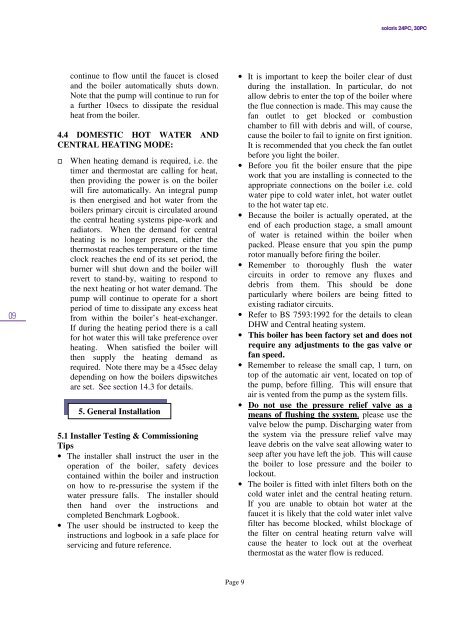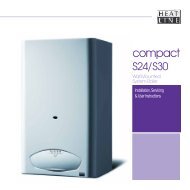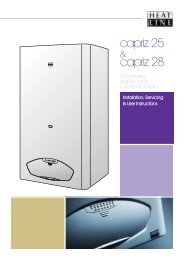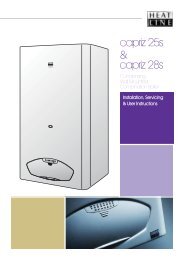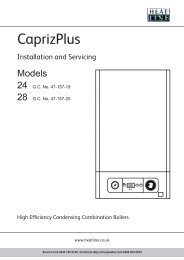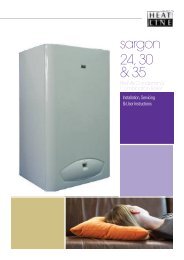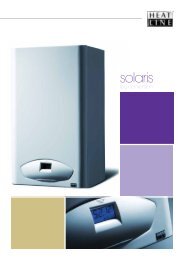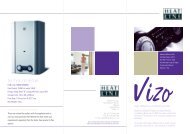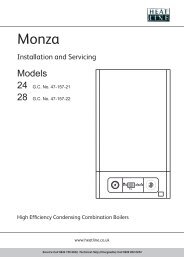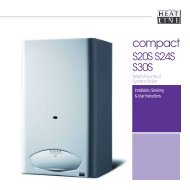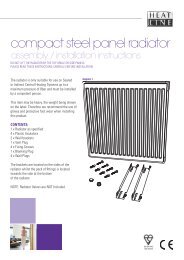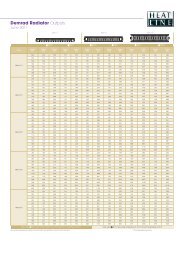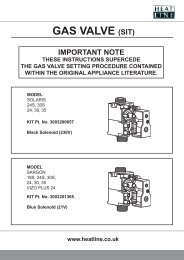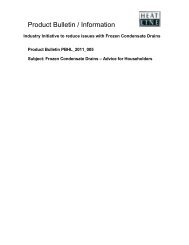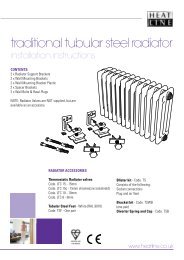solaris 24PC 30PC - Heatline
solaris 24PC 30PC - Heatline
solaris 24PC 30PC - Heatline
Create successful ePaper yourself
Turn your PDF publications into a flip-book with our unique Google optimized e-Paper software.
<strong>solaris</strong> <strong>24PC</strong>, <strong>30PC</strong><br />
09<br />
continue to flow until the faucet is closed<br />
and the boiler automatically shuts down.<br />
Note that the pump will continue to run for<br />
a further 10secs to dissipate the residual<br />
heat from the boiler.<br />
4.4 DOMESTIC HOT WATER AND<br />
CENTRAL HEATING MODE:<br />
<br />
When heating demand is required, i.e. the<br />
timer and thermostat are calling for heat,<br />
then providing the power is on the boiler<br />
will fire automatically. An integral pump<br />
is then energised and hot water from the<br />
boilers primary circuit is circulated around<br />
the central heating systems pipe-work and<br />
radiators. When the demand for central<br />
heating is no longer present, either the<br />
thermostat reaches temperature or the time<br />
clock reaches the end of its set period, the<br />
burner will shut down and the boiler will<br />
revert to stand-by, waiting to respond to<br />
the next heating or hot water demand. The<br />
pump will continue to operate for a short<br />
period of time to dissipate any excess heat<br />
from within the boiler’s heat-exchanger.<br />
If during the heating period there is a call<br />
for hot water this will take preference over<br />
heating. When satisfied the boiler will<br />
then supply the heating demand as<br />
required. Note there may be a 45sec delay<br />
depending on how the boilers dipswitches<br />
are set. See section 14.3 for details.<br />
5. General Installation<br />
5.1 Installer Testing & Commissioning<br />
Tips<br />
• The installer shall instruct the user in the<br />
operation of the boiler, safety devices<br />
contained within the boiler and instruction<br />
on how to re-pressurise the system if the<br />
water pressure falls. The installer should<br />
then hand over the instructions and<br />
completed Benchmark Logbook.<br />
• The user should be instructed to keep the<br />
instructions and logbook in a safe place for<br />
servicing and future reference.<br />
• It is important to keep the boiler clear of dust<br />
during the installation. In particular, do not<br />
allow debris to enter the top of the boiler where<br />
the flue connection is made. This may cause the<br />
fan outlet to get blocked or combustion<br />
chamber to fill with debris and will, of course,<br />
cause the boiler to fail to ignite on first ignition.<br />
It is recommended that you check the fan outlet<br />
before you light the boiler.<br />
• Before you fit the boiler ensure that the pipe<br />
work that you are installing is connected to the<br />
appropriate connections on the boiler i.e. cold<br />
water pipe to cold water inlet, hot water outlet<br />
to the hot water tap etc.<br />
• Because the boiler is actually operated, at the<br />
end of each production stage, a small amount<br />
of water is retained within the boiler when<br />
packed. Please ensure that you spin the pump<br />
rotor manually before firing the boiler.<br />
• Remember to thoroughly flush the water<br />
circuits in order to remove any fluxes and<br />
debris from them. This should be done<br />
particularly where boilers are being fitted to<br />
existing radiator circuits.<br />
• Refer to BS 7593:1992 for the details to clean<br />
DHW and Central heating system.<br />
• This boiler has been factory set and does not<br />
require any adjustments to the gas valve or<br />
fan speed.<br />
• Remember to release the small cap, 1 turn, on<br />
top of the automatic air vent, located on top of<br />
the pump, before filling. This will ensure that<br />
air is vented from the pump as the system fills.<br />
• Do not use the pressure relief valve as a<br />
means of flushing the system, please use the<br />
valve below the pump. Discharging water from<br />
the system via the pressure relief valve may<br />
leave debris on the valve seat allowing water to<br />
seep after you have left the job. This will cause<br />
the boiler to lose pressure and the boiler to<br />
lockout.<br />
• The boiler is fitted with inlet filters both on the<br />
cold water inlet and the central heating return.<br />
If you are unable to obtain hot water at the<br />
faucet it is likely that the cold water inlet valve<br />
filter has become blocked, whilst blockage of<br />
the filter on central heating return valve will<br />
cause the heater to lock out at the overheat<br />
thermostat as the water flow is reduced.<br />
Page 9


